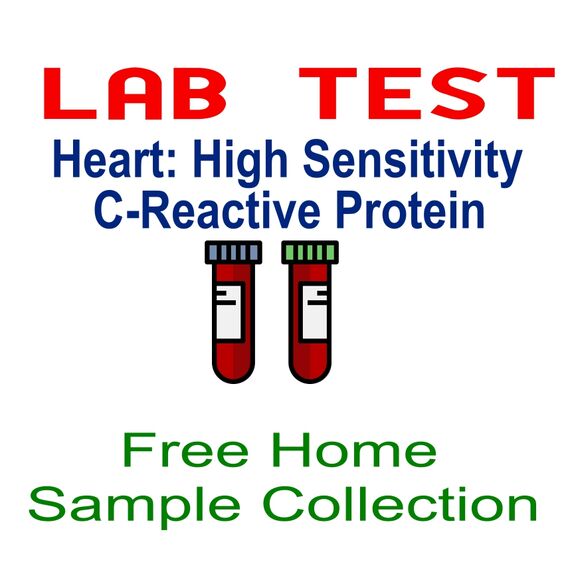This test is aslo known as hsCRP Test, Cardiac CRP Test, high sensitivity C-reactive protein Test, CRP Test for heart disease.
The High Sensitivity C-Reactive Protein (hs-CRP) test measures the levels of C-reactive protein, a marker of inflammation, in the blood. It is a more sensitive version of the standard C-reactive protein test. The hsCRP test helps assess the presence of low-grade inflammation in the body, which can be associated with various conditions, including cardiovascular diseases
Lab tests often ordered with a hs-CRP test:
When hs-CRP test is ordered, it may be part of a broader assessment of cardiovascular risk. More often, the following tests are ordered parallel to hs-CRP test:
- Lipid Profile:
- Aim: Measures levels of cholesterol and triglycerides in the blood.
- Why Is It Mandated: A complete lipid profile (including LDL, HDL, total cholesterol, and triglycerides) is used to assess cardiovascular risk in conjunction with hs-CRP.
2. Fasting Glucose and Hemoglobin A1c (HbA1c):
- Aim: To assess blood sugar levels and identify pre-diabetes or diabetes.
- Why Is It Mandated: Diabetes is a risk factor for cardiovascular disease, and blood sugar levels can correlate with inflammation.
3. Lipoprotein (a) [Lp(a)]:
- Aim: Measures levels of Lp(a), a genetic variant of LDL (bad) cholesterol.
- Why Is It Mandated: Elevated Lp(a) is a risk factor for atherosclerotic diseases such as coronary artery disease.
4. Homocysteine:
- Aim: Elevated homocysteine levels have been associated with an increased risk of cardiovascular events.
- Why Is It Mandated: To evaluate another potential risk factor for heart disease, particularly if there is a personal or family history of cardiovascular problems without traditional risk factors.
5. Fibrinogen:
Aim: A coagulation factor that is associated with thrombosis and inflammation.
Why Is It Mandated: Elevated fibrinogen can be an independent risk factor for cardiovascular disease.
6. NT-proBNP or BNP (N-terminal pro b-type Natriuretic Peptide or Brain Natriuretic Peptide):
Aim: To assess heart strain and heart failure.
Why Is It Mandated: These markers are elevated in heart failure, which can be related to chronic inflammation.
7. Insulin:
Aim: To assess insulin levels and sensitivity.
Why Is It Mandated: Insulin resistance is a component of metabolic syndrome, which is associated with increased cardiovascular risk.
8. Complete Blood Count (CBC):
Aim: To provide a broad picture of blood health.
Why Is It Mandated: Certain CBC parameters can inform about inflammation and cardiovascular risk; for example, high levels of red cells or platelets can be associated with increased risk.
9. Renal Function Test:
Aim: To assess kidney function.
Why Is It Mandated: Kidney dysfunction can contribute to cardiovascular risk and may be associated with higher levels of inflammation.
10. Thyroid Function Tests (TFTs):
Aim: Thyroid hormones affect heart rate and cholesterol levels.
Why Is It Mandated: To identify thyroid dysfunction, which can contribute to cardiovascular risk.
These tests, along with hs-CRP, can assist to generate a comprehensive cardiovascular risk profile and may aid in steering treatment decisions like lifestyle changes or medication to decrease the risk of heart disease. All these tests are fequently used in combination with each other as a support with evidence to deliver directions.
hsCRP test may be ordered in many conditions to assess the inflammation levels as below:
- To Evaluate Cardiovascular Risk: The hsCRP test is commonly used to assess cardiovascular risk, especially in individuals without obvious symptoms but with other risk factors such as high blood pressure, obesity, or a family history of heart disease.
- To Appraise The Inflammatory Conditions: The hsCRP test may be ordered to evaluate the presence and severity of inflammatory conditions such as rheumatoid arthritis, lupus, or inflammatory bowel disease.
- To Observe The Changes To Treatment: In individuals with chronic inflammatory conditions or cardiovascular diseases, the hsCRP test helps monitor the effectiveness of treatment interventions and assess disease activity over time.

No special preparation required
None
Next day or after a few days based on any other combination tests.
A blood sample drawn from a vein in your arm.
Sample report in a format
Aucun avis trouvé


